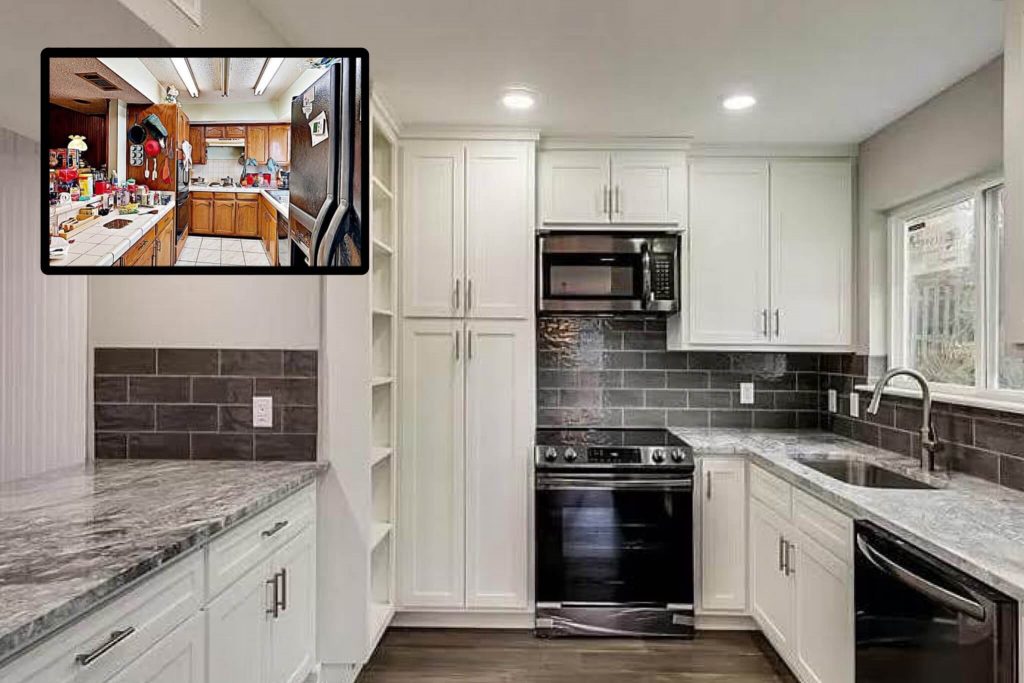One of my favorite ways to invest in real estate is to find properties, renovate them, and ultimately sell them. This is a process known as flipping houses. I’m sure you’ve heard of flipping houses, but how does one actually do it and make a profit?
Today, I want to take you through my process for flipping houses.
Contents:
Step 1: Buy A House
Step 2: Check The Small Things
Step 3: Get Videos & Measurements Early
Step 4: Make A To-Do List and Get Bids
Step 5: Make A List Of What You’re Buying
Step 6: Start the Remodel
Conclusion
Step 1: buy a house
Unsurprisingly, the first step to flipping a house is to buy a property.
There’s a strategy to find distressed properties to flip called “Driving For Dollars.” Basically, you drive around a neighborhood and write down the address of any house that looks like it has potential. How do you know if a property has potential?
Here are the things that I usually look for:
– Overgrown lawn
– Property appears vacant
– Lack of maintenance on the exterior
Notice that these are all things that you can determine just by driving by in your car. Once you’ve got a few candidates, you need to see if you can get in contact with the owner to see if they are interested in selling the house.
If you are new to flipping properties and want some help, we have a program where we will basically walk you through the process. You can submit the address of the property you’re interested in and your information and we will do whatever we can to get into contact with the owner and start the flipping process. We’ll basically go through the entire process with you.
If you already have a property in mind or want to learn more, click here!
Step 2: Check the small things
Once you’ve bought the house, it’s time to start preparing for the flip.
In my time flipping houses, I’ve found that it is always worth it to hire an inspector to walk through the house. I do this because inspectors are very diligent and know exactly what little issues to be looking for.
I don’t have them do a full inspection of the house. It’s a flip and I know it has some major issues so I don’t need them to point them all out to me. Instead, I have them just look for those smaller things.
Some of the small issues can become big problems financially.
Here is a list of things I have inspectors look for:
– Check every single outlet to make sure they work
– Check the plumbing, including gas lines
– Check the locks on all the windows
– Check the windows to make sure they open and close smoothly
– Check for wood rot
– Check the foundation
It’s always better to check for these things at the start because if you have any issues, you can add them to the list of things for the contractors to do. It’s much more expensive to have them come back out as problems come up than it is to just get everything done at once.
Inspections are always worth the upfront cost because they can save you a lot of money.
Step 3: Get videos & measurements early
Have your inspector get some videos of the issues that need to be addressed. It’s one thing to tell a contractor what needs to be addressed, but it’s another thing altogether to be able to show them.
It’s also great to get videos (and pictures) so you can make before and after comparisons. These are super great for social media because people love to see the transformation. Show it to them to create some buzz for your property!
Get measurements of the house as early as you can. If you don’t, you will find yourself driving to the house often.
Measurements are important because they can also help you determine how much material you need to order. This has been particularly important recently because the material can take time to get to you with all the supply chain issues. I’ve found that waiting on materials for one part of the renovation can actually hold up the entire project. If you order the right amount from the start, you will be able to finish your project faster.
In addition to letting you know how much material you need, measurements can also help you determine what size furniture you should get and where you can place it. It’s much easier to plan when you know the exact size of the rooms.
Step 4: Make A to-do list & get bids
Once you’ve had the house inspected and gotten all your measurements, make a list of everything that needs to be done. This list should be as specific as possible.
Not only will this help you easily keep track of everything, but it will also help you find the right contractor for the job.
Some contractors will do almost everything you tell them, but because nothing is in writing, once they get to the end they’ll bring you something that they claim you never told them and try to charge you more to get it done. Please note that this is not always malicious. It’s easy to forget things when you have a long list to do. If you have that list for them in writing and you give it to them at the beginning, they can’t forget.
They also can’t try to charge more for something they already said they would do. It’s always best to have a comprehensive list in writing at the start.
If you don’t really know what to expect price-wise, get bids from multiple contractors. If you have multiple options you’re more likely to find a good price.
We’ve done enough flips to generally know what things should cost. We usually look for around $24-26 per square foot for a basic remodel. Then, we add our big items on top of that.
Another great thing about this detailed to-do list is it will help different teams coordinate and understand what needs to be done. You’ll have different people for sheetrock and painting than you will for plumbing and electricity. If everyone is on the same page, the work will be smoother.
step 5: Make A list of what you're buying
We have a spreadsheet for every remodel we do that has a list of what we’re buying, where we’re buying it from, and how much it costs. This is a great way to stay on budget.
We also include the links to each item in the spreadsheet. This is helpful because if you need to order something for the house, you can do it in the click of a few buttons. Always try to do this before the work on the house actually starts because some items may require a lot of research. If you do this research ahead of time, you can simply click and buy when needed.
Planning in advance just makes everything easier.
There are some materials that we don’t track like sheetrock. It’s just easier for the contractor to keep track and order it as they need it than it would be for us to keep track of it.
step 6: Start The Remodel
Once you’ve gotten the house, taken measurements, made a to-do list, gotten contractors, and planned what you’re going to buy, you’re finally ready to start remodeling the house.
Always start by fixing any foundation issues. It is quintessential to begin with the foundation before anything else. The entire house is built on the foundation and if you start the remodel before addressing the foundation, you will likely need to do some things twice. Do your best to avoid redundancies and save money.
Also, keep in mind that kitchens and bathrooms sell houses. Do not cut corners in these rooms. If you find yourself needing to cut some things to save money, cut it from somewhere else. Under no circumstances should you opt for nicer flooring over a nicer kitchen.
If you are uncertain and feel like you need guidance, talk to a realtor. They sell a lot of houses every year, so they know what people are looking for.
conclusion
This is my six-step process for remodeling a house. If you’re flipping a house, most of your work should be in the preliminary stages of the remodel. Planning is so important in a project like this.
Of course, it probably won’t go perfectly. Something comes up almost every time and that’s okay. Following this list will help you minimize the amount of issues you face.
If you feel like you need some help or have any questions, we would love to help you out. Don’t hesitate to call the number on our site. Also, if you have a property and want to include us on your journey, you can do that here!
If you would like to buy or sell a property, we can also help with that!
Follow us on social media to stay up to date with all of our content, including clips from our weekly podcast where we talk about everything real estate, investing, and Dallas-Fort Worth.






